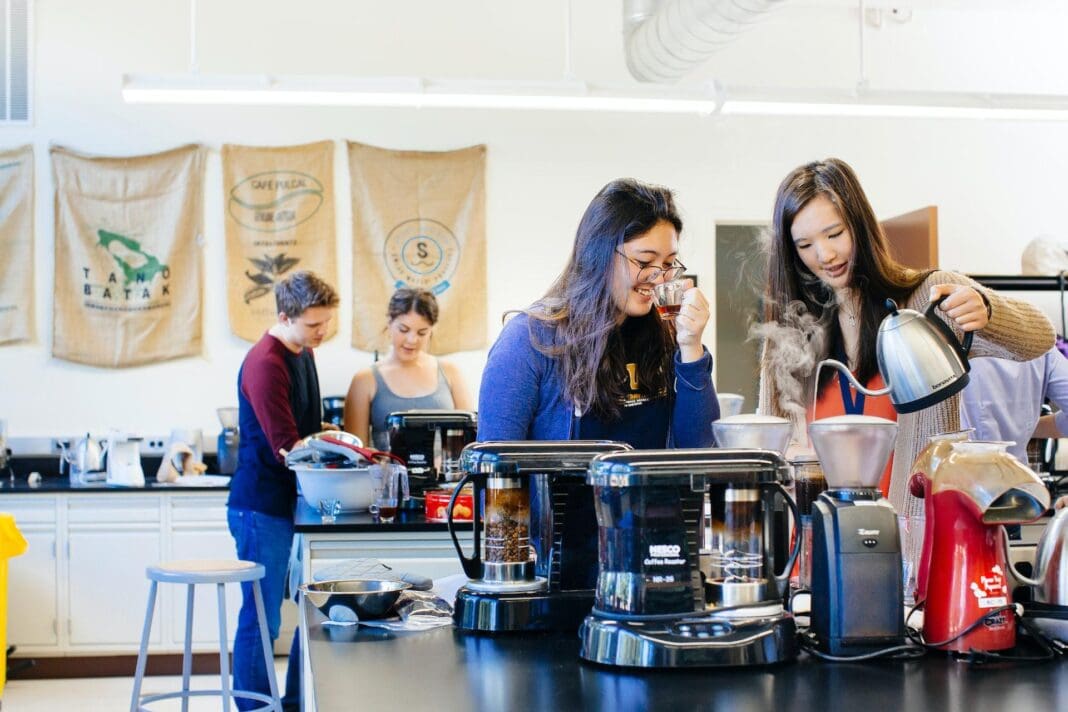Uncommon Courses is an occasional series from The Conversation U.S. highlighting unconventional approaches to teaching.
The Design of Coffee: An Introduction to Chemical Engineering
In 2012, my colleague professor Tonya Kuhl and I were drinking coffee and brainstorming how to improve our senior-level laboratory course in chemical engineering. Tonya looked at her coffee and suggested, “How about we have the students reverse-engineer a Mr. Coffee drip brewer to see how it works?”
A light bulb went off in my head, and I said, “Why not make a whole course about coffee to introduce lots of students to chemical engineering?”
And that’s what we did. We developed The Design of Coffee as a freshman seminar for 18 students in 2013, and, since then, the course has grown to over 2,000 general education students per year at the University of California, Davis.
The course focus is hands-on experiments with roasting, brewing and tasting in our coffee lab.
For example, students measure the energy they use while roasting to illustrate the law of conservation of energy, they measure how the pH of the coffee changes after brewing to illustrate the kinetics of chemical reactions, and they measure how the total dissolved solids in the brewed coffee relates to time spent brewing to illustrate the principle of mass transfer.
The course culminates in an engineering design contest, where the students compete to make the best-tasting coffee using the least amount of energy. It’s a classic engineering optimization problem, but one that is broadly accessible – and tasty.
Coffee plays a huge role in culture, diet and the U.S. and global economy. But historically, relatively little academic work has focused on coffee. There are entire academic programs on wine and beer at many major universities, but almost none on coffee.
The Design of Coffee helps fill a huge unmet demand because students are eager to learn about the beverage that they already enjoy. Perhaps most surprisingly, many of our students enter the course professing to hate coffee, but by the end of the course they are roasting and brewing their own coffee beans at home.
Many students are shocked to learn that black coffee can have fruity, floral or sweet flavors without adding any sugar or syrups. The most important lesson from the course is that engineering is really a quantitative way to think about problem-solving.
For example, if the problem to solve is “make coffee taste sweet without adding sugar,” then an engineering approach provides you with a tool set to tackle that problem quantitatively and rigorously.
Tonya and I originally self-published our lab manual, The Design of Coffee: An Engineering Approach, to keep prices low for our students.
Now in its third edition, it has sold more than 15,000 copies and has been translated to Spanish, with Korean and Indonesian translations on the way.
Years ago, a student in our class told the campus newspaper, “I had no idea there was an engineering way to think about coffee!” Our main goal is to teach students that there is an engineering way to think about anything.
The engineering skills and mindset we teach equally prepare students to design a multimillion-dollar biofuel refinery, a billion-dollar pharmaceutical production facility or, most challenging of all, a naturally sweet and delicious $3 cup of coffee. Our course is the first step in preparing students to tackle these problems, as well as new problems that no one has yet encountered.
This article is republished from The Conversation, an independent nonprofit news site dedicated to sharing ideas from academic experts. If you found it interesting, you could subscribe to our weekly newsletter.
Read more: Brewing a great cup of coffee depends on chemistry and physics Is it OK for teens to drink coffee?
William D. Ristenpart receives funding from the National Science Foundation, the Coffee Science Foundation, and the Specialty Coffee Association.








